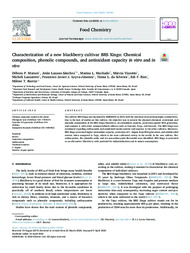Characterization of a new blackberry cultivar BRS Xingu: chemical composition, phenolic compounds, and antioxidant capacity in vitro and in vivo.
Characterization of a new blackberry cultivar BRS Xingu: chemical composition, phenolic compounds, and antioxidant capacity in vitro and in vivo.
Author(s): MORAES, D. P.; LOZANO-SÁNCHEZ, J.; MACHADO, M. L.; VIZZOTTO, M.; LAZZARETTI, M.; LEYVA-JIMENEZ, F. J. J.; SILVEIRA, T. da; RIES, E. F.; BARCIA, M. T.
Summary: The cultivar BRS Xingu was launched by EMBRAPA in 2015 with the intention of presenting higher productivity. Due to the lack of studies on this cultivar, the objective was to present the physical?chemical, centesimal, and phenolic composition of the BRS Xingu blackberry, its antioxidant capacity, protection against ROS generation, and compare it with other commercialized cultivars such as Guarani, Tupy, and Xavante. The BRS Xingu was prominent regarding anthocyanin and condensed tannin content and superior to the other cultivars. Moreover, BRS Xingu presented higher antioxidant capacity, protection of C. elegans from ROS generation, and soluble solid content when compared to Tupy, which is the most cultivated variety in the world. In the new cultivar, five anthocyanins, five phenolic acids, and ten non-anthocyanin flavonoids were identified. BRS Xingu is presented as an alternative blackberry with potential for industrialization and in natura consumption.
Publication year: 2020
Types of publication: Journal article
Keywords: Amora Preta, Cultivar BRS Xingu
Observation
Some of Embrapa's publications are published as ePub files. To read them, use or download one of the following free software options to your computer or mobile device. Android: Google Play Books; IOS: iBooks; Windows and Linux: Calibre.
Access other publications
Access the Agricultural Research Database (BDPA) to consult Embrapa's full library collection and records.
Visit Embrapa Bookstore to purchase books and other publications sold by Embrapa.

